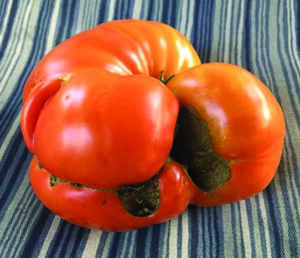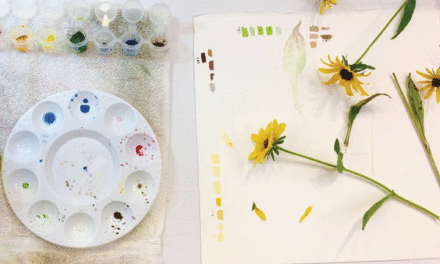
Catfacing may impair tomato fruit aesthetically but doesn’t render it completely inedible. (Photo courtesy University of Maryland Extension)
Tomatoes are the most popular plant grown in home vegetable gardens and like other vegetables, there are any number of problems that can interfere with growing a good crop.
In Maryland, tomato plants are susceptible to several diseases, pests, and, at times, unfavorable weather conditions that can disrupt their growth, productivity, and/or eating quality.
University of Maryland Extension’s Home and Garden Information Center has identified the most common problems of tomatoes, dividing them in three categories: Symptoms on leaves, symptoms on the tomato fruit and symptoms affecting the whole plant.
Common leaf symptoms can come as spots, blotches discoloration, damage from pests or curling. Septoria leaf spot shows up as small, round gray spots with dark margins on the lower leaves, usually when the first fruits begin to form.
Favored by wet weather, it is caused by a fungus, Septoria lycopersici. Fungal lesions gradually enlarge, coalesce, and cause leaves to turn yellow and die.
Early blight or alternaria leaf spot is seen as small, irregular brown lesions, often with yellow halos, that enlarge rapidly; a“bull’s-eye” pattern appears within the lesions. Lower leaves are affected first.
Individual lesions enlarge and coalesce and can kill entire leaves. The disease can also infect stems and roots. This fungal disease can spread in wet and dry weather but is favored by rainy weather. It often co-occurs with septoria leaf spot. Bacterial diseases may look similar to early blight with small, dark spots (⅛ inch or less); yellowing leaves. The bacteria can overwinter on crop residue and are seed-borne.
For Septoria leave spot, early blight and bacterial diseases, UME advises to cover the soil around plants with mulch and do not crowd plants together. Avoid overhead watering and working with plants when the foliage is wet. Fertilize plants to support new growth. Spray with a labeled copper fungicide when symptoms are first observed. Remove infected plants and dispose of all infected crop residue.
Damage from spider mites resembles tiny yellow or white spots that can coalesce to cause yellow blotching; leaf undersides may appear dirty.
Spider mites can be seen on leaf undersides with the naked eye or using a hand lens. They suck chlorophyll from leaf tissues, resulting in yellow discoloration.
Horticultural oil and insecticidal soap are most effective on mite eggs. Soap with pyrethrum can be used. Use when damage is first observed. Spray in early morning when it’s cool and plants have rehydrated overnight. Caution: Spraying badly damaged leaves can cause further injury.
Yellowing leaves is a sign of Fusarium wilt, the most common wilt disease of garden tomatoes in Maryland.
The plant’s lower leaves turn yellow and then brown with leaf and stem wilting during the day.
When the outside of an infected stem is scraped you will see browning of the internal vascular tissue underneath.
There is no cure for this disease. Plants must be removed and destroyed. If you grow your own plants be sure to sterilize all plant growing equipment and supplies with a 10% chlorine bleach solution and use sterile soil-less growing media.
Purple leaves are a signal of low phosphorus in the soil. This is very common in new tomato seedlings and transplants. Plants often recover when roots are fully established in the garden.
Curled leaves could mean a few things are going on in your plants. Water or heat stress could be the most common cause, but it could also be a result of herbicide drift from another area or farm field, aphids, or a mosaic virus.
Aphids are small, soft-bodied insects that may be green, pink, or black, usually found on the young growth of the plant. They suck plant sap and excrete sticky honeydew. Naturally occurring predators such as ladybird beetles control them.
Tobacco mosaic virus and tomato mosaic virus are two of the more common viruses that affect tomatoes and can be transmitted by aphids, leafhoppers and thrips. Symptoms include leaves twisting, curling, distorted, smaller than normal in size; leaves may feel rough, and crinkled.
If viral symptoms extend to the fruit, the entire plant needs to be removed and discarded. Control weeds around the garden and insect pests that suck plant sap.
Leaves with holes or evidence of chewing could either be from flea beetles or hornworms. Flea beetles are among the earliest emerging insects (late April-early May). They are tiny, 1/10 of an inch, usually shiny black or brown. Adult beetles jump away when disturbed, much like fleas. Using a row cover fabric or insect mesh over plants from planting until flowering is suggested for control.
For severe infestations spray your plants with an “organic” insecticide-pyrethrum, neem, or spinosad. You can also dust plants with diatomaceous earth.
Tobacco or tomato hornworms are a mid to late-summer pest. When scouting plants, remove caterpillars by hand and discard. A large percentage is controlled by a wasp parasitoid. The cocoons of the Braconid wasps look like grains of rice attached to the hornworm’s back. Do not kill parasitized hornworms! Let the wasps complete their life cycle so they can multiply. A parasitized hornworm stops eating and eventually dies.
On tomato plant stems, adventitious roots can pop up as small knobs, swellings, or bumps that are usually harmless and caused by plant genetics (natural growth) or stressors in the environment. No action needs to be taken.
Problems with the fruit of tomato plants come as discolored areas, cracks or misshapen tomatoes.
Blossom end rot often looks like dark, leathery, sunken areas on the blossom end of the tomato, most prevalent on enlarging fruit.
It is caused by a lack of calcium in cell walls, or excessive use of nitrogen fertilizers.
Keep plants well-watered and mulched through the growing season. Also, check soil pH and amend it accordingly.
Sunscalding looks like pale-colored, sunken, or blistered areas on tomato fruits from prolonged exposure to full sun. It will cause fruit to be inedible.
Stinkbug feeding damage stinkbug feeding causes a “cloudy spot” on tomato fruits. The nymphs and adults insert their piercing mouthparts and suck plant sap from fruits, leaves, buds, or blossoms of the plant.
Cloudy spots in the fruit can be cut out and it does not otherwise affect eating quality.
Anthracnose disease is caused by more than a dozen species of fungus in the genus Colletotrichum. The fungi can overwinter in seeds, soil, and plant residues and on fruit it resembles circular sunken spots with darkened centers, usually on overripe fruits.
UME recommends picking fruit before it ripens fully.
Tomatoes with catfacing are misshapen, often with deep crevices or holes and scarring in the blossom end.
This is common in home gardens, most often on the early fruit clusters of large-fruited cultivars.
The cause is thought to be exposure to temperatures below 50 degrees F before or after transplanting. Cracks radiating outward or in concentric rings around the top of the fruit and small cracks on the fruit surface signal rainchecking. This is caused by fluctuations in soil moisture, persistent rainfall, and heavy dews.
Like managing for anthracnose, pick fruits before they ripen fully.
Tomato zippering symptoms are dry, brown scars resembling zippers extend from the stem to the blossom end of fruits. This occurs when flower parts stick to the developing fruit. Cool weather and plant genetics are considered to be contributing factors as well. This is superficial and does not affect yields or eating quality.
Symptoms on the whole plant are wilting either from Fusarium wilt, described earlier, or Southern blight.
Southern blight symptoms include wilting and the collapse of individual stems or entire plants. Lower stems turn dark brown. White strands of fungal mycelium and small tan, round sclerotia (resembling seeds) may be found at the base of the stem. During the growing season, remove wilted and blighted plants and the mycelium clinging to stems and mulch. Deep plowing can provide good control by burying the sclerotia. Keep the soil pH above 6.5 and add compost to garden beds on a regular basis.




